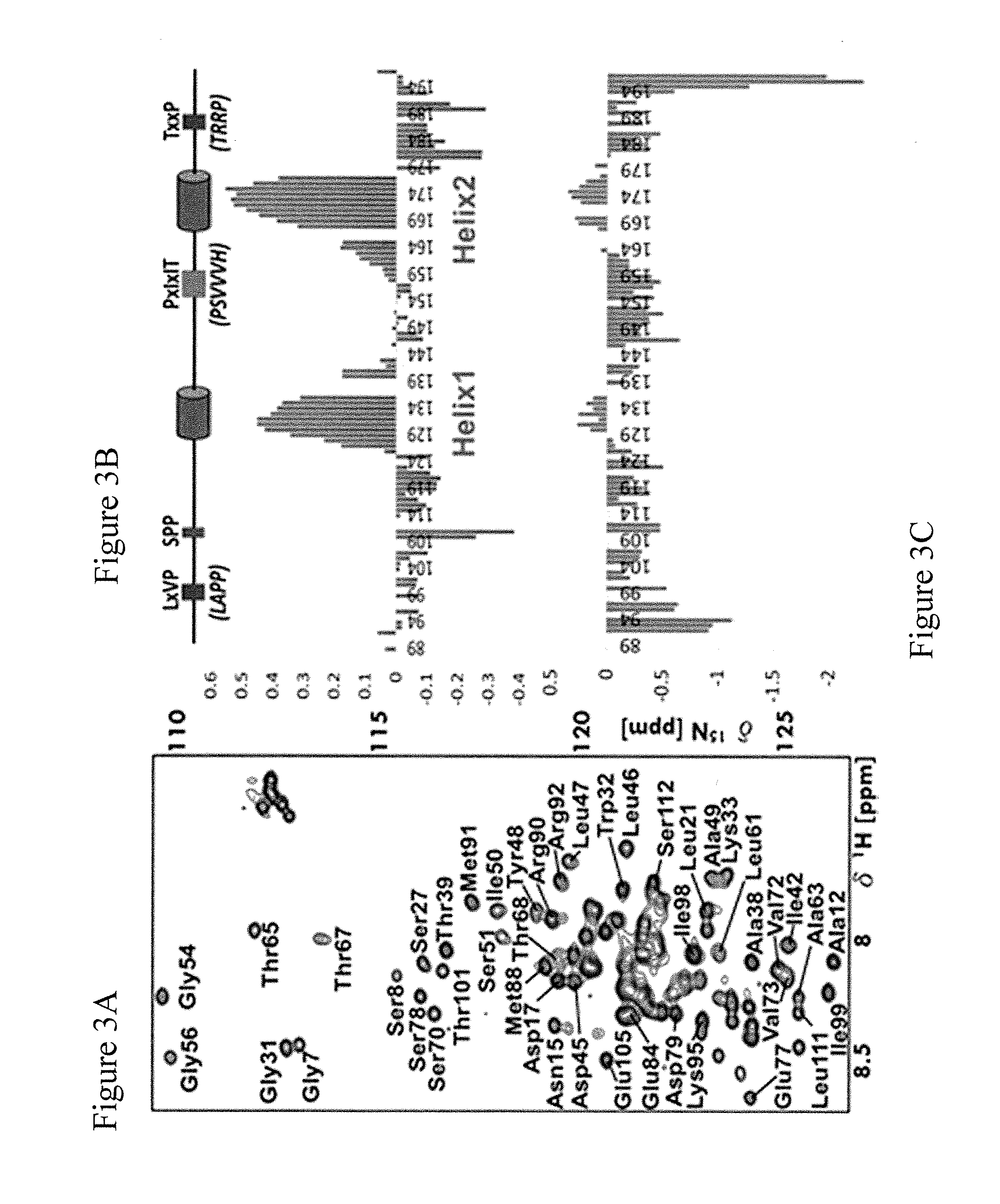Method and compositions for treatment of calcineurin-related diseases
a calcineurin-related disease and composition technology, applied in the field of calcineurin-related diseases, can solve the problems of limited drug selectivity and likely non-selectivity of active site inhibitors, and achieve the effect of increasing the function of protein serine/threonine phosphatase and increasing the amount of dephosphorylation
- Summary
- Abstract
- Description
- Claims
- Application Information
AI Technical Summary
Benefits of technology
Problems solved by technology
Method used
Image
Examples
example 1
Identification of a the RCAN1 Calcineurin-Binding Domain
[0072]RCAN1 has a structured RNA-binding domain (amino acid positions 1-88) at the N-terminus. ITC results show this domain does not interact directly with calcineurin. Instead, calcineurin interactions occur within RCAN189-197, as shown in FIG. 2: 96LAPP99 (SEQ ID NO: 12) is an example of the LxVP (SEQ ID NO: 10) motif and 154PSVVVH159 (SEQ ID NO: 13) is an example of the PxIxIT (SEQ ID NO: 9) motif. Additional regions proposed to play a role in both calcineurin binding and regulation were observed to be: the 108SPPASPP114 (SEQ ID NO: 3) motif which was hypothesized to act as a pseudo-substrate inhibitor, the 145ELH147 (SEQ ID NO: 5) motif which was hypothesized to bind calcineurin, and the 186TxxP189 (SEQ ID NO: 11) motif which was hypothesized to function in calcineurin metal biogenesis to interact at the calcineurin active site. See, Martinez-Martinez et al., Proc Natl Acad Sci USA 106, 6117-22 (2009) and FIG. 2.
example 2
Identification of RCAN1 Residues Outside the Canonical Motifs that Interact Directly with Calcineurin
[0073]Solution state NMR spectroscopy was used to fully characterize RCAN1 residues and motifs outside the canonical motifs that interact directly with calcineurin at a molecular level. RCAN189-197 is an intrinsically disordered protein in solution. The amino acid sequence specific backbone assignment of RCAN189-197 identified using chemical shift analysis two regions with preferred a-helical secondary structure elements: helix1—amino acid positions 130-138, about 40% populated; and helix2—amino acid positions 166-179, about 55% populated. See, FIG. 2A and FIG. 3B. These regions also have reduced fast timescale dynamics as determined using 15N-hetNOE techniques. See, FIG. 3C. The transiently structured regions correlate with the previously biochemically identified motifs.
[0074]Results of ITC show that calcineurin and RCAN189-197 interacted strongly and had a Kd of 10 nM. Based on thi...
example 3
Determination of the Role of RCAN1128-164 in Calcineurin Binding
[0076]To comprehensively characterize the role of RCAN1, especially residues RCAN1128-164 in calcineurin binding and regulation, ten different RCAN1 constructs (SEQ ID NOs: 2-11) were designed and synthesized. See, FIG. 2B. The constructs were engineered to contain the distinct interaction domains identified using NMR, ITC, and mutagenesis data. The constructs were expressed as GST- or MBP-fusion proteins and were purified using affinity chromatography, SEC chromatography, and heat purification. RCAN1 constructs are stable up to 95° C., as is typical for intrinsically disordered proteins. The constructs are highly soluble and are concentrated to greater than or equal to 1 mM concentration. As long as they are thoroughly protected from protease degradation, e.g. by autoclaved purification buffers and 1 M NaOH washes of all purification equipment / columns, the constructs were viable in storage for long periods of time at −...
PUM
| Property | Measurement | Unit |
|---|---|---|
| Structure | aaaaa | aaaaa |
| Affinity | aaaaa | aaaaa |
| Interaction | aaaaa | aaaaa |
Abstract
Description
Claims
Application Information
 Login to View More
Login to View More - R&D
- Intellectual Property
- Life Sciences
- Materials
- Tech Scout
- Unparalleled Data Quality
- Higher Quality Content
- 60% Fewer Hallucinations
Browse by: Latest US Patents, China's latest patents, Technical Efficacy Thesaurus, Application Domain, Technology Topic, Popular Technical Reports.
© 2025 PatSnap. All rights reserved.Legal|Privacy policy|Modern Slavery Act Transparency Statement|Sitemap|About US| Contact US: help@patsnap.com



